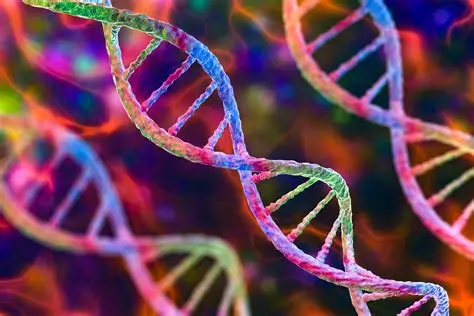
23/06/2024
Breastfeeding and epigenetics
Definition
Epigenetics is the study of changes in gene activity that do not involve a change in the DNA sequence and that can be transmitted during cell division.
Epigenetic modifications are induced by the environment in the broadest sense: the cell constantly receives all kinds of signals informing it about its environment, so that it specialises during development, or adjusts its activity to the situation. These signals, including those linked to our behaviour (diet, smoking, stress…), can lead to changes in the expression of our genes, without affecting their sequence.
The phenomenon may be transitory, but there are perennial epigenetic modifications that persist when the signal that induced them disappears (INSERM 2015).
The role of breastfeeding
Breastfeeding provides epigenetic information to the child in the form of maternal stem cells, hormones and miRNA messengers which play an important role in metabolism and protection against non-communicable diseases (NCDs), known as “diseases of civilisation” (obesity, diabetes, cancer, hypertension, cardiovascular diseases…). Lancet Breastfeeding Series 2016
MicroRNA in human milk
“Breast milk is a complex, multiform liquid that plays an essential role in the development of infants. It is composed of water, carbohydrates, fats, proteins, vitamins and minerals, as well as numerous bioactive compounds such as hormones, oligosaccharides and immune proteins. Additionally, breast milk contains microRNAs, which have been shown to regulate gene expression and have an impact on various aspects of infant development”. Slyk-Gulewska P et al. MicroRNA as a new bioactive component in breast milk 2023, https://doi.org/10.1016/j.ncrna.2023.06.003
“More than 1,400 miRNAs have been identified in human milk. Their profile depends on the mother’s diet, intestinal flora, genetic factors and the time elapsed since birth. It is likely that this profile adapts to the changing needs of the breastfed baby. These miRNAs have been associated with the modulation of the expression of more than 4,000 DNA sites involved in development and immune function. […] It appears that miRNAs are resistant to pasteurisation. Cow’s milk contains miRNAs and they have been detected in industrial milks made from cow’s milk, but at very low levels.” Ames SR et al. 2023 https://pubmed.ncbi.nlm.nih.gov/37055920/
“Human Breast Milk microRNAs, Potential Players in the Regulation of Nervous System : “Human breast milk (HBM) is a gold standard for preterm and term infant nutrition. It combines all essential nutrients and bioactive factors, either synthesized in the lactating breast or transferred via systemic circulation. It provides essential functions for the lactating mother and the breastfed infant. HBM composition is dynamic and may vary according to various factors related to mother, infant, environment and physiology. Among the whole variety of bioactive components, it includes miRNAs.” Freiría-Martínez L et al. 2023 https://pubmed.ncbi.nlm.nih.gov/37513702/
“Human milk is the biological fluid with the highest exosome amount and is rich in microRNAs (miRNAs). These are key regulators of gene expression networks in both normal physiologic and disease contexts, miRNAs can influence many biological processes and have also shown promise as biomarkers for disease. One of the key aspects in the regeneration of the nervous system is that there are practically no molecules that can be used as potential drugs. In the first weeks of lactation, we know that human breast milk must contain the mechanisms to transmit molecular and biological information for brain development.” Freiría-Martínez L et al. 2023 https://pubmed.ncbi.nlm.nih.gov/37513702/
“The miRNAs present in human milk come from mammary epithelial cells. Those included in the exosomes will resist digestion and can pass into the bloodstream of the breastfed baby. miRNAs have been found in many body fluids. Many of them may be present in these various fluids, and some are particularly abundant in a specific fluid. The variable profile of miRNAs in human fluids suggests that these miRNAs are selectively synthesised for each fluid. Human milk is one of the most miRNA-rich human body fluids. In contrast, industrial milks contain almost no miRNAs (whose biological activity will not necessarily be the same).” Freiría-Martínez L et al. 2023 https://pubmed.ncbi.nlm.nih.gov/37513702/
“There is accumulating evidence that milk functions as a transmitter or relay between the maternal lactation genome and epigenetic regulation of genes of the milk recipient, who under physiological conditions is the newborn infant, but under Neolithic conditions is the human consumer of bovine milk. In fact, epigenetic processes are considered to play a pivotal role in regulating tissue-specific gene expression and hence alterations in these processes can induce long-term changes in gene expression and metabolism which persist throughout life course. Because human milk protects against diseases of civilization in later life, the World Health Organization recommends exclusive breastfeeding for up to six months with continuation of breastfeeding for at least the first two years.” Melnik & Schmitz 2017, https://pubmed.ncbi.nlm.nih.gov/28933365/
Epidermal Growth Factor (EGF)
As babies gets complementary feeding, they are given increasing quantities of a variety of foods, while the volume of breast milk decreases. This leads to the formation of passage channels associated with goblet cells in the small intestine and colon. EGF could be a major regulator of the inhibition of the creation of passage channels before weaning, via its binding to goblet cells, according to studies in mice. Although there are other translocation pathways in the intestinal walls, these channels are the main route for transporting molecules present in the intestinal lumen to the lamina propria. These molecules, including bacterial and food antigens, will stimulate the local immune system and facilitate the regulation of T cells to promote antigen tolerance, with a long-term impact. This mechanism is associated with the risk of developing colitis, inflammation or intestinal cancer for the rest of one’s life. Ames et al. 2023 https://pubmed.ncbi.nlm.nih.gov/37055920/
Bibliography (chronological)
- Ames SR et al. Comparing early life nutritional sources and human milk feeding practices : personalized and dynamic nutrition supports infant gut microbiome development and immune system maturation. Gut Microbes 2023 ; 15(1) : 2190305. https://pubmed.ncbi.nlm.nih.gov/37055920/
- Slyk-Gulewska P et al, MicroRNA as a new bioactive component in breast milk. Science Direct, 2023 https://doi.org/10.1016/j.ncrna.2023.06.003
- Freiría-Martínez L et al. Human breast milk microRNAs, potential players in the regulation of nervous system. Nutrients 2023 ; 15 : 3284. https://pubmed.ncbi.nlm.nih.gov/37513702/
- UNICEF 2023 Emerging research: Epigenetics and the microbiome https://www.unicef.org.uk/babyfriendly/news-and-research/baby-friendly-research/infant-health-research/epigenetics-microbiome-research/
- Melnik BC, W. Stremmel, R. Weiskirchen, S.M. John, G. Schmitz, Exosome-derived microRNAs of human milk and their effects on infant health and development, Biomolecules 11 (6) (2021 Jun 1). https://www.mdpi.com/2218-273X/11/6/851
- Pauwels S et al. The Influence of the Duration of Breastfeeding on the Infant’s Metabolic Epigenome (2019)”Our results support the hypothesis that breastfeeding could induce epigenetic changes in infants.” https://pubmed.ncbi.nlm.nih.gov/31234503/
- Moossavi et al. Composition and Variation of the Human Milk Microbiota Are Influenced by Maternal and Early-Life Factors (2019), Cell Host & Microbe 25, 324–335 February 13, 2019 a 2019 Elsevier Inc. https://doi.org/10.1016/j.chom.2019.01.011
- Santiago Rio J, Epigenetics of Breastfeeding: 4 Diseases and Disorders That Breast Milk Could Protect Against (2018) https://www.whatisepigenetics.com/epigenetics-of-breastfeeding-4-diseases-and-disorders-that-breast-milk-could-protect-against/
- Epigenetics and breastfeeding, ICEA https://icea.org/epigenetics-and-breastfeeding/ (2018) with references
- Melnik and Schmitz, Milk’s Role as an Epigenetic Regulator in Health and Disease, 2017 https://www.ncbi.nlm.nih.gov/pubmed/28933365
- Pires Hartwig F et al. Breastfeeding effects on DNA methylation in the offspring: A systematic literature review (2017) https://journals.plos.org/plosone/article?id=10.1371/journal.pone.0173070
- Indrio F et al. Epigenetic Matters: The Link between Early Nutrition, Microbiome, and Long-term Health Development. Front Pediatr 2017, 5: 178 (14 pages) https://www.ncbi.nlm.nih.gov/pubmed/28879172
- Floris I et al., Roles of MicroRNA across Prenatal and Postnatal Periods. (2016) Review, Int J Mol Sci 2016, 17: 1994 (12 pages) https://www.ncbi.nlm.nih.gov/pubmed/27916805/
- Alsaweed, M.; Hartmann, P.E.; Geddes, D.T.; Kakulas, F. MicroRNAs in breastmilk and the lactating breast: Potential immuno- protectors and developmental regulators for the infant and the mother. Int. J. Environ. Res. Public Health 2015, 12, 13981–14020. https://www.mdpi.com/1660-4601/12/11/13981
- Laurel Wilson, UNICEF UK Babyfriendly Hospital Talk 2014 https://www.unicef.org.uk/babyfriendly/epigenetics-and-breastfeeding-laurel-wilson/
- Verduci E et al. Epigenetic effects of human breast milk (2014) Nutrients, doi: 10.3390/nu60417
- Lillycrop KA; Burdge GC. Epigenetic mechanisms linking early nutrition to long term health. Best Pract. Res. Clin. Endocrinol. Metab. 2012, 26, 667–676. https://pubmed.ncbi.nlm.nih.gov/22980048/
- Admyre C et al.Exosomes with Immune Modulatory Features Are Present in Human Breast Milk. J. Immunol. 2007, 179, 1969–1978. https://doi.org/10.4049/jimmunol.179.3.1969
